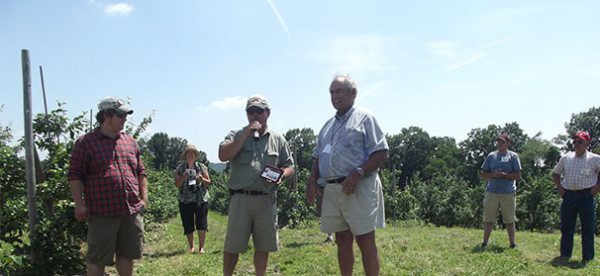

Oct 3, 2013Farmers’ market sales change the way farm grows fruit
When Ben Wenk came back from college in 2006, he wanted to find a way to contribute to the family business, Three Springs Fruit Farm in Aspers, Pa. When he heard that a new farmers’ market in Philadelphia was looking for vendors, he jumped on the opportunity.
That move to direct marketing ended up changing the way the farm grows and sells its fruit and vegetables. These days, Three Springs still has wholesale customers, but also sells at eight farmers’ markets a week – in Philadelphia, Cumberland County, Pa., Baltimore and Washington, D.C., Ben said.
The Wenk family has been farming in Adams County, Pa., since the early 1800s, but didn’t go into fruit completely until the 1960s, said Dave Wenk, Ben’s father, who runs Three Springs Fruit Farm with his brother, John, and Ben.
Dave and John represent the sixth generation of the family to farm. When they were growing up the family had 70 acres, all apples, and only needed extra workers for six to eight weeks a year. If they couldn’t find enough workers at the right time, they were in trouble. To try to attract workers year round, the family started expanding their acreage and diversifying their crops, Dave said.
They diversified even more when Ben came home and started selling at farmers’ markets. These days, the farm grows on about 450 acres, including 250 of apples, 70 of (cling and freestone) peaches, 3 of pears, 23 of sour cherries and 3 of sweet cherries (under bird netting). They also grow blackberries, raspberries, gooseberries, currants, hardy kiwi, table grapes, asparagus and other vegetables, as well as plums, pluots and apricots, Dave said.
On market days, Ben and his staff pack the produce in a truck (in a variety of containers), drive to the location, sell for a few hours, then pack up and drive back. It’s a long, but profitable, day, he said.
The mid-Atlantic region is a good place to sell direct, with large population centers like Philadelphia, Washington, D.C., Baltimore, Harrisburg, Pittsburgh and New York City within a few hours’ drive. Ben thinks the buy-local movement is still gathering momentum, and won’t be peaking any time soon.
When he first started selling at farmers’ markets, Ben didn’t see much potential in south-central Pennsylvania, the family farm’s backyard. More and more of his neighbors started showing an interest in buying local food, however. A farmers’ market opened up in nearby Carlisle a few years ago, and sales there have gone well, he said.
Customers who prefer “local” often have specific expectations about the food they buy. Ben and his staff often have to gauge how they respond to certain questions. If someone asks “Is this stuff sprayed?”, for example, Ben might mention the farm’s IPM and scouting programs. That’s enough to satisfy the majority of inquiries, he said.
“For some folks, nothing matters but whether it’s organic or not,” he said, but “when we’re honest and transparent about what we do, that’s enough for most people.”
Ben blogs frequently about the farm’s growing practices (find the blog at www.threespringsfruitfarm.com) and his employees are well versed in those practices, so he trusts that the message is getting across.
Three years ago, Three Springs Fruit Farm was certified as a sustainable producer by the Food Alliance, a voluntary certification program. That status has resonated well with retail customers, Ben said.
There are about 16 full-time workers on the farm these days, which increases to nearly 30 during apple harvest. Another dozen or so employees work at the farmers’ markets, Ben said.
Ben and his dad discussed the buy-local movement and more during a visit from the International Fruit Tree Association in July. As an example of the way the farm’s growing practices have changed, Dave showed the visitors a block of Honeycrisp planted in 2008. The trees are on Malling 26 rootstock, on an 8-by-15-foot spacing.
Like most fruit operations in Adams County, Pa., all of the Three Springs orchards are between 800 feet and 1,200 feet in elevation. Honeycrisp seems to do better at higher elevations, where it’s cooler. The color is better and there are fewer bitter pit problems. The next Honeycrisp block they plant will be close to 1,200 feet, about as high as they can go, Dave said.
Dave also showed the visitors blocks of September Wonder Fuji and Cameo. Fuji is popular and gets on the market early, while Cameo is also popular and stores well.
Three Springs doesn’t have its own controlled atmosphere storage, but rents CA space from neighboring farms. That allows them to sell apples nearly year round, Dave said.














